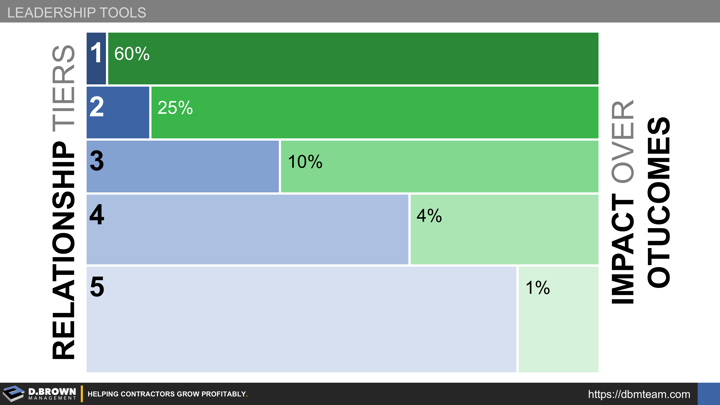You can quite simply look at relationship management in three critical buckets (read more):
- People You Have Met: Meet as many people as you can. You won't always see how they will all connect, but they will.
- Favors You've Done for Others: Do as many favors for others as you can. Make sure bucket #2 is at least twice as full as bucket #3.
- Favors You've Received from Others: You will need things from others. The size of buckets #1 and #2 ensure success in #3.
When contractors are in the first few stages of growth, keeping track of these relationships is relatively simple and happens mostly in the owner's head.
As a contractor grows and moves into stages 4, 5, and 6+, the relationships have multiplied into the thousands with a complex web of multiple connections throughout your entire team. This is where you have to add management structure, standards, tools, operating rhythms, and feedback loops to the process of building and managing relationships.
This is especially true when it comes to the relationships that help you develop work. Remember business development fact #2 of 4: You likely don't even know a fraction of your potential customers, and they don't know you.
The five-tier diagram above is only representative and there are not perfectly hard lines between them.
TIER 1
As you look at your organization, start by thinking about the top 10-25 relationships that have the most direct control or strong influence over the work you get. These relationships are directly managed at the Owner/CEO/President level while involving others.
To be successful today and tomorrow, this group should be perhaps an 80/20 divide between those relationships that are your current market focus, with some that you expect to become a future major markets.
Depending on your business structure and market strategy, this top tier of relationships may account for 50-80% of your revenue and an even greater share of your gross margins.
TIER 2
To prepare your business for sustainability, scalability, and succession, the next tier is extremely important. This tier of relationships is about 3X larger than the first tier. Depending on your market dynamics and stage of growth, this tier may be 25-75 people.
These relationships are managed across the second tier of leadership within the company. The role of the Owner/CEO/President is to coach and assist their direct reports on the management of these relationships.
This group of relationships will consist of other key people from companies in the first tier along with future high-potential relationships. Also, an 80/20 mix as above. For example, while the relationships in tier 1 above may be Owners and C-Level, tier 2 will have members of their management teams that are closer to the work, such as the VP of Preconstruction.
Keep in mind that lack of key relationships being distributed across the management team is one of the nine succession challenges contractors face. Relationships are also one of the eighteen details that improve cash flow and create a foundation for effective change management.
OTHER TIERS
Think about every person you work with that makes your company operate. All of them are important. There will be one tier that has the most people in it who you simply want to connect with regularly. This may be as simple as cards around certain holidays.
Depending on the size of your company and market dynamics, there may be other tiers in-between.
Think about how you would define them.
Think about how you would manage those relationships. What tier gets recognized on their birthday? What tier gets a holiday gift along with a card? What tier gets company or team level gifts as compared to individual?
If you have 1,500 employees, there may be 5 or 6 tiers. If you have 50 employees, there are probably 2 or 3 tiers.
Don't make it too complicated. Manage the relationships consistently and with true underlying value. Everyone can see through robotic processes and there is a point where that even becomes damaging.
WARNING: Though we talk about the favor buckets above, avoid relationships based on quid pro quo where favors are done with an expectation of something specific in return. Those are not genuine relationships. In some cases, they cross over into moral gray areas or even illegal activities.
Remember that trust forms the foundation of all meaningful relationships, and it is built upon the smallest of details. Remembering someone's favorite coffee order and having it waiting for them at an early meeting goes a long way. Knowing their daughter loves American Girl and getting her one on a special birthday with a custom shirt - perhaps with your logo on it - will never be forgotten.
Learn more about what it takes to build and maintain trust - and how easy it is to break.
One of the biggest challenges in growth between stages 3-5 is shifting responsibility for business development from the owner to a broader group of people and a system. Relationship management is part of this growth.
An experienced and unbiased 3rd party can be invaluable in helping you work through these details.
All relationships begin with a simple conversation. Let's talk.

